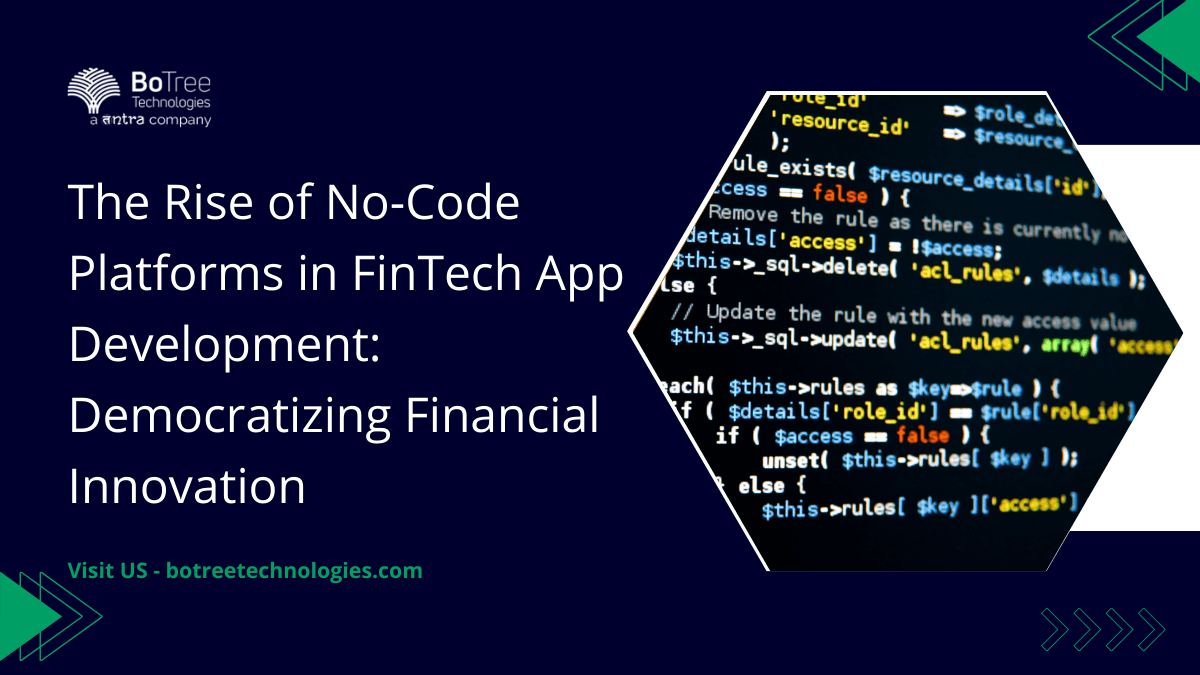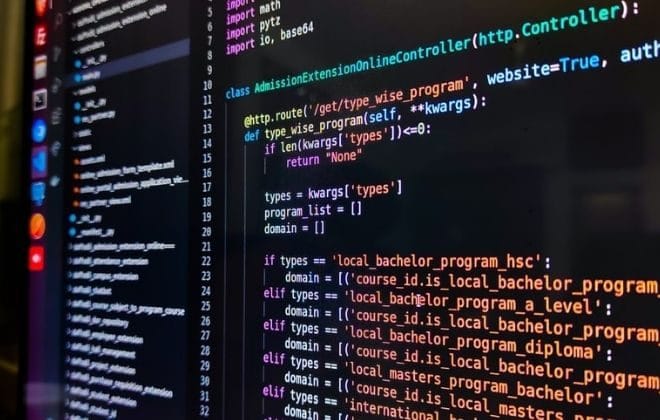
The Rise of No-Code Platforms in FinTech App Development: Democratizing Financial Innovation
The digital world moves fast and the financial app needs to move even faster. People rely on it to not only be safe, but reliable. We live in a world where a FinTech’s ability to build a secure app in time and maintain it is seriously in question, given talent shortages.
That puts pressure on the financial institutions building these apps to not only create them efficiently but also be able to advise on what an ideal financial app should be without the technical skill to build one themselves.
As the need for innovative FinTech app development services has increased, innovations have come out with the power to make developing apps easier and more accessible: no-code and low-code development.
Our focus is on no-code development, what it is, what it means for financial app development, and where it could go from here.
What is No-Code?
No-code is a software development idea based on allowing anyone with few or no programming skills to build an application. As the name implies, it does not involve looking at or writing any kind of code. The backend of any app is a mystery to the average user with no programming skills.
No-code app development is seen as a way to allow business employees who have the institutional background and understand what the app needs to be but don’t necessarily have the skills to write code for it to create software applications and add functionalities as needed.
It is a way of letting those who know the business and its audience best build the app. For FinTech, the app is an inextricable part of the business model. It has to be available and reliable. Allowing FinTech experts to build it is a great way to ensure that business and user needs are accounted for, to create a harmonious interaction on the app.
No-code development separates programming language from syntax and logic and instead relies on visual build elements and natural language to create functionalities and deliver your vision rapidly.
The difference between no-code and low-code development is in the name: low-code will require you to incorporate some programming language knowledge and is meant for professional developers looking to reduce the time to delivery.
With definitions out of the way, let’s get into how this revolutionary technology is transforming FinTech app development. Has it gotten truly democratic out there?
How No-Code Platforms Are Transforming The Landscape Of FinTech App Development
The concept of democratization comes into play when you consider how no-code development works. You and everyone who can use a mouse and a keyboard can build an app. Before this, you had to not only understand the fundamentals of development but also learn programming languages to even begin to bring any app idea you may have to life.
How is this newfound freedom transforming FinTech app development?
As we mentioned earlier, the ability for anyone to build an app means that FinTech no longer have to go through the exhausting process of providing exhaustive descriptions of what they need, risking the possibility that they get results that don’t quite hit the mark.
The experts in the field who know what the app needs to be for optimal service provision can simply build the app themselves and leave the backend work to the platforms/builders that support the technology.
The benefits of having an expert in the field build the app means it can be tailored to represent what users expect while meeting the industry’s strict regulatory standards, and with faster deliveries on any new additions.
On that note, let’s talk about the main benefits of using no-code platforms in FinTech.
The Benefits Of Using No-Code Solutions In FinTech
These benefits apply not just to FinTech but to no-code app development in general. For FinTech CEOs, here’s what you can expect to enjoy when you switch to a no-code paradigm:
- Speeding Up The Development Process
Development in the traditional sense is a lengthy process with many moving parts. While you might need an expert to clean up the results of what you create, which the platforms enabling it will provide, the time it takes for your idea to go from your head to an app people can use is much shorter.
At the speed of no-code development, you could have a simple app completed in a few hours and take only a few weeks to complete a sophisticated customer enterprise application. Traditional timelines, by comparison, take months on the low end.
- Lowering Costs
There is no better way to cut costs than to reduce the amount of people and time it takes to build an app. The speed at which you can develop the app will not only mean that you do not have to pay as much in the end but that you need to pay fewer people to complete an app.
- Enabling More Rapid Prototyping
Traditionally, it takes a while to present an idea and get back to what it will look like when ready for deployment to the main app. In no-code development, you can do all prototyping from the very beginning and as you make updates over time, in a short amount of time.
Rapid prototyping allows a FinTech to test ideas at a convenient timeline and bring new functionalities users want much faster
- Focus Is Shifted To The Core Of The App
A no-code application development platform means spending more time getting to know the users and creating an app they will love using. With the time constraints out of the way and a fast turnaround on ideas and prototypes, you can experiment with the app as much as you want without a lot of effort.
Focusing on the app and how well it works for your business and users means more satisfaction all around, which is great for metrics like customer retention and, therefore, the FinTech’s profitability.
- Updates Are Easy
FinTech apps and infrastructure are an obvious target for cybercriminals looking to steal data or make life harder for these companies in extortion schemes. This often comes down to flaws in the apps or other malfunctions that, in more cases than anyone should be comfortable with, could have been easily fixed with an update.
Traditional development takes a lot of time to develop and implement fixes for flaws that could potentially expose user data to criminals. With codeless development, FinTechs can quickly roll out updates before anyone has time to exploit a bug.
Cyberattack breaches and other serious security incidents are some of the worst hits a FinTech’s reputation can take, as people’s trust is eroded, leading to the userbase migrating to other options.
- Flexibility
With codeless development, you can shift away from or toward a new idea quickly, allowing you to test it and get feedback in a shorter time. Given that it is not costly to try out new things, it is easy for a company to implement or take back something without adversely affecting its relationship with the user.
What Does No-Code Mean For The Future Of Financial Technology Innovation
Did we mention times are changing? No-code development will too. It will get better, faster, easier to use, and more capable in the hands of anyone with a clear idea of what FinTech app they want to build.
Going forward, this is what no-code will mean for FinTech innovation:
- The Ability To Build More Than Apps
No-code development is not limited to app building alone. You can use them for other things too, including:
- Websites and web applications
- Databases and data management tools
- Workflow automation tools
- Social media tools.
The only thing limiting you is your imagination. You could make the entire IT department powering your FinTech codeless and reap the benefits of being able to build whatever you want on short notice.
- Everything Will Be Sped Up
At the time of writing, 2023 is drawing to a close. By now, Large Language Models are capable of writing clean, usable code by interpreting instructions written in natural language (like English), and turning it into code you can integrate into your development process.
The speed these tools bring is going to supercharge what you can build on no-code development platforms, meaning that your app can always be on the cutting edge.
But if you can use those tools, so can cybercriminals. It is hard to predict what hackers can do with that kind of speed and ability and how many people who previously couldn’t attack you now find themselves capable of doing so.
However, it means that developing without code, which is the fastest way to build apps, will be your best chance at providing a secure experience to your users. The message is clear: going codeless is the future!
- There Will Be More Opportunity Innovate
If it seems like this point just keeps coming up, well, that’s because it is extra true. The limitations of needing an app and waiting for someone else to hopefully build it how you want will free up more room for FinTech companies to innovate internally and in collaboration with their users.
With codeless development, there is room for more people to be heard, regardless of their technical ability in programming.
Go No-Code and Leverage Your Current Capabilities for More
Leveraging a company’s internal expertise to build an app that works for everyone is not just a fun experience but one that encourages innovation by sourcing ideas from different perspectives.
As the digital age rapidly changes, FinTech that don’t change with it get left behind. If you cannot innovate fast enough, iterate rapidly, and change with the times in a reasonable time, it is likely that you will not just struggle to get users but to keep any you may have convinced in the first place.
Going codeless is a great way to future-proof your FinTech from any rapid changes the market may undergo, as you can change right along with them and continue to serve your users at the cutting edge.
Given how quickly you can actualize any ideas presented, it makes collaboration a more seamless process.
Find out how to go the no-code route today and see the benefits for yourself. Contact us Today.




